
Illustrative Math Alignment: Grade 6 Unit 1
Expressions and Equations
Lesson 6: Write Expressions Where Letters Stand for Numbers
Use the following Media4Math resources with this Illustrative Math lesson.
| Thumbnail Image | Title | Body | Curriculum Nodes |
|---|---|---|---|
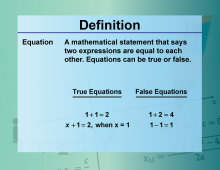
|
Math Definitions Collection: Solving Equations | OverviewThe Equations collection on Media4Math is an invaluable resource for students and educators alike, offering a comprehensive set of definitions related to equations. This collection includes essential terms such as linear equations, quadratic equations, and polynomial equations. Each term is clearly defined, providing students with a solid foundation in understanding the various types of equations they will encounter in their studies. |
Numerical and Algebraic Expressions, Applications of Equations and Inequalities, Variable Expressions, Variables and Unknowns, Inequalities, Applications of Linear Functions, Solving Multistep Equations, Numerical Expressions, Solving One-Step Equations, Polynomial Functions and Equations, Quadratic Equations and Functions and Solving Two-Step Equations |
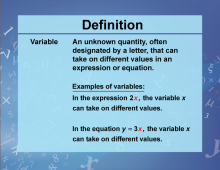
|
Math Definitions Collection: Variables and Unknowns |
OverviewThis collection aggregates all the definition image cards around the topic of Variables and Unknowns terms and vocabulary. There are a total of 20 terms. This collection of resources is made up of downloadable PNG files that you can easily incorporate into a presentation.
|
Variables and Unknowns |

|
Math Video Definitions Collection: Equations | OverviewDiscover the comprehensive collection of videos on Equations Vocabulary. This curated series offers clear definitions and explanations of essential math terms related to equations, covering a wide range of concepts and skills. From foundational terms to more advanced vocabulary, these resources support students in mastering the language of math. |
Numerical and Algebraic Expressions, Applications of Equations and Inequalities, Variable Expressions, Variables and Unknowns, Inequalities, Applications of Linear Functions, Solving Multistep Equations, Numerical Expressions, Solving One-Step Equations, Polynomial Functions and Equations, Quadratic Equations and Functions and Solving Two-Step Equations |

|
Math Video Collection: Algebra Applications Video Series: Equations |
OverviewThis collection aggregates all the math videos and resources in this series: Algebra Applications Video Series: Equations. There are a total of 23 resources. This collection of resources is made up of downloadable MP4, transcripts, and other resources files that you can easily incorporate into a presentation.
|
Applications of Equations and Inequalities, Variables and Unknowns and Variable Expressions |
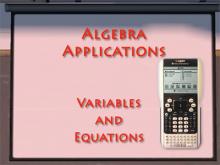
|
VIDEO: Algebra Applications: Variables and Equations | VIDEO: Algebra Applications: Variables and Equations
TopicEquations |
Applications of Equations and Inequalities, Variables and Unknowns and Variable Expressions |
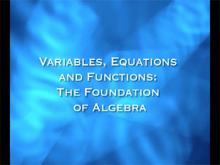
|
VIDEO: Algebra Nspirations: Variables and Equations | VIDEO: Algebra Nspirations: Variables and Equations
TopicEquations |
Applications of Equations and Inequalities, Variables and Unknowns and Variable Expressions |

|
Closed Captioned Video: Algebra Applications: Variables and Equations | Closed Captioned Video: Algebra Applications: Variables and EquationsTopicEquations |
Applications of Equations and Inequalities, Variables and Unknowns and Variable Expressions |
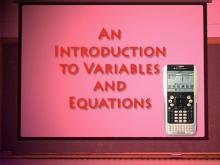
|
Closed Captioned Video: Algebra Applications: Variables and Equations, 1 | Closed Captioned Video: Algebra Applications: Variables and Equations, 1TopicEquations DescriptionThe video introduces algebraic expressions and their ability to represent both known and unknown quantities. It defines variables as placeholders for unknowns and explains equations as relationships between two expressions. Key concepts include solving for variables and understanding the role of variables in equations. Key vocabulary includes variable, unknown quantity, and equation. The applications discussed include investigations into real-world scenarios such as honeybee populations and river geology. |
Applications of Equations and Inequalities, Variables and Unknowns and Variable Expressions |

|
Closed Captioned Video: Algebra Applications: Variables and Equations, 2 | Closed Captioned Video: Algebra Applications: Variables and Equations, 2TopicEquations DescriptionThe video investigates the geometry of river meanders using the concept of the meander ratio, calculated as the ratio of a river’s sinuous length to its straight-line length. It uses a TI-Nspire calculator to simulate river paths and compute ratios. Key vocabulary includes meander ratio, sinuous length, and geometric modeling. Applications highlight the mathematical modeling of natural phenomena and the occurrence of pi in nature. |
Applications of Equations and Inequalities, Variables and Unknowns and Variable Expressions |
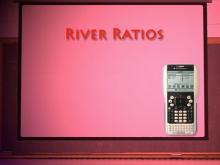
|
Closed Captioned Video: Algebra Applications: Variables and Equations, 3 | Closed Captioned Video: Algebra Applications: Variables and Equations, 3TopicEquations DescriptionThis segment explores the impact of colony collapse disorder on honey production using statistical data. It introduces box and whisker plots and the calculation of mean as statistical tools to analyze honey yields. Key vocabulary includes colony collapse disorder, box plot, and mean. Applications include modeling bee population declines and their broader ecological and agricultural implications. |
Applications of Equations and Inequalities, Variables and Unknowns, Variable Expressions and Applications of Ratios, Proportions, and Percents |

|
Closed Captioned Video: Algebra Nspirations: Variables and Equations | Closed Captioned Video: Algebra Nspirations: Variables and Equations
Ever since the mathematics of the Babylonians, equations have played a central role in the development of algebra. Written and hosted by internationally acclaimed mathematics educator Dr. Monica Neagoy, this video traces the history and evolution of equations. It explores the two principal equations encountered in an introductory algebra course--linear and quadratic--in an engaging way. The foundations of algebra are explored and fundamental questions about the nature of algebra are answered. In addition, problems involving linear and quadratic equations are solved using the TI-Nspire graphing calculator. Algebra teachers looking to integrate hand-held technology and visual media into their instruction will benefit greatly from this series. |
Applications of Equations and Inequalities, Variables and Unknowns and Variable Expressions |
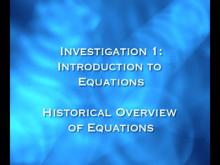
|
Closed Captioned Video: Algebra Nspirations: Variables and Equations, 1 | Closed Captioned Video: Algebra Nspirations: Variables and Equations, Segment 1
In this Investigation we get a historical overview of equations. This video is Segment 1 of a 2 segment series related to Variables and Equations. |
Applications of Equations and Inequalities, Variables and Unknowns and Variable Expressions |
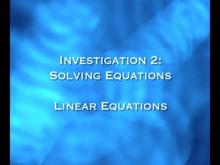
|
Closed Captioned Video: Algebra Nspirations: Variables and Equations, 3 | Closed Captioned Video: Algebra Nspirations: Variables and Equations, Segment 3
In this Investigation we solve linear and quadratic equations. This video is Segment 3 of a 4 segment series related to Variables and Equations. Segments 3 and 4 are grouped together. |
Applications of Equations and Inequalities, Variables and Unknowns and Variable Expressions |
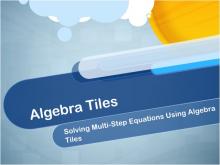
|
Closed Captioned Video: Algebra Tiles: Solving Multi-Step Equations Using Algebra Tiles | Closed Captioned Video: Algebra Tiles: Solving Multi-Step Equations Using Algebra Tiles
Video Tutorial: Algebra Tiles: Solving Multi-Step Equations Using Algebra Tiles. In this tutorial, students review how to model equations with algebra tiles. Then the video focuses on how to solve multi-step equations with algebra tiles. DescriptionThis is part of a collection of video tutorials the topic of Algebra Tiles.This series of videos describes what algebra tiles are and how they can be used to model numbers, operations, expressions, and equations. Use this series if you are incorporating the use of algebra tiles in your instruction. |
Algebra Tiles--Expressions and Equations |

|
Closed Captioned Video: Algebra Tiles: Solving One-Step Equations Using Algebra Tiles | Closed Captioned Video: Algebra Tiles: Solving One-Step Equations Using Algebra Tiles
DescriptionThis is part of a collection of video tutorials the topic of Algebra Tiles.This series of videos describes what algebra tiles are and how they can be used to model numbers, operations, expressions, and equations. Use this series if you are incorporating the use of algebra tiles in your instruction. —CLICK PREVIEW TO SEE THE VIDEO TUTORIAL— To see the complete collection of the video tutorials on this topic, click on this link.The following section reviews the basics of algebra tiles. Use this material as background material, and also as a supplement to the video series. |
Algebra Tiles--Expressions and Equations |
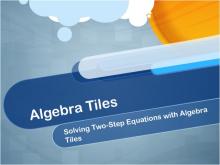
|
Closed Captioned Video: Algebra Tiles: Solving Two-Step Equations Using Algebra Tiles | Closed Captioned Video: Algebra Tiles: Solving Two-Step Equations Using Algebra Tiles
DescriptionThis is part of a collection of video tutorials the topic of Algebra Tiles.This series of videos describes what algebra tiles are and how they can be used to model numbers, operations, expressions, and equations. Use this series if you are incorporating the use of algebra tiles in your instruction. —CLICK PREVIEW TO SEE THE VIDEO TUTORIAL— To see the complete collection of the video tutorials on this topic, click on this link.The following section reviews the basics of algebra tiles. Use this material as background material, and also as a supplement to the video series. |
Algebra Tiles--Expressions and Equations |

|
Closed Captioned Video: Overview of Variables and Equations | Closed Captioned Video: Overview of Variables and Equations
In this video segment, get an overview of variables and equations, along with the evolution of algebraic notation. |
Applications of Equations and Inequalities, Variables and Unknowns and Variable Expressions |
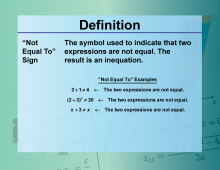
|
Definition--Equation Concepts--"Not Equal To" | Not Equal ToTopicEquations DefinitionThe "Not Equal To" symbol (≠) is used to indicate that two values are not equal. DescriptionThe "Not Equal To" symbol is crucial in mathematics as it denotes inequality between two expressions. This symbol is used in various mathematical contexts, such as solving inequalities, comparing numbers, and expressing conditions in algebraic equations. For example, in the inequality 𝑥 ≠ 5, it means that x can be any number except 5. |
Numerical and Algebraic Expressions |
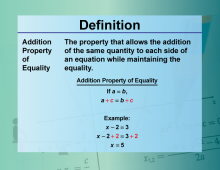
|
Definition--Equation Concepts--Addition Property of Equality | Addition Property of EqualityTopicEquations DefinitionThe Addition Property of Equality states that if you add the same value to both sides of an equation, the equality remains true. DescriptionThe Addition Property of Equality is a fundamental principle in algebra. It asserts that for any real numbers a, b, and c, if a = b, then a + c = b + c. This property is used to solve equations and maintain balance. For example, to solve x − 3 = 7, you add 3 to both sides to get x = 10. |
Applications of Equations and Inequalities |
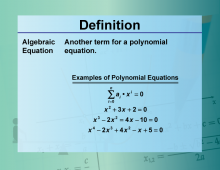
|
Definition--Equation Concepts--Algebraic Equation | Algebraic EquationTopicEquations DefinitionAn algebraic equation is a mathematical statement that shows the equality of two algebraic expressions. It's also another way of referring to a polynomial equation. DescriptionAlgebraic equations are central to algebra and involve variables, constants, and arithmetic operations. They are used to represent relationships and solve problems. For instance, the equation 2x + 3 = 7 can be solved to find x. Algebraic equations come in various forms, including linear, quadratic, and polynomial equations. |
Applications of Equations and Inequalities |
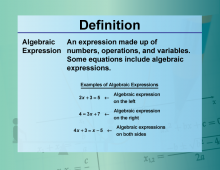
|
Definition--Equation Concepts--Algebraic Expression | Algebraic ExpressionTopicEquations DefinitionAn algebraic expression is a combination of variables, constants, and arithmetic operations, without an equality sign. DescriptionAlgebraic expressions are fundamental components of algebra. They represent quantities and relationships without asserting equality. Examples include 3x + 4 and 5y − 2. Unlike equations, expressions cannot be solved but can be simplified or evaluated for given variable values. |
Numerical and Algebraic Expressions |
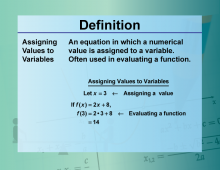
|
Definition--Equation Concepts--Assigning Values to Variables | Assigning Values to VariablesTopicEquations DefinitionAssigning values to variables involves giving specific values to variables in an equation or expression. DescriptionAssigning values to variables is a fundamental process in algebra. It involves substituting variables with specific numbers to evaluate expressions or solve equations. For example, in the equation y = 2x + 3 assigning x = 4 gives y = 11. |
Variable Expressions |
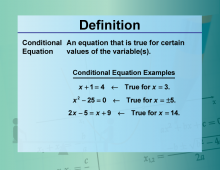
|
Definition--Equation Concepts--Conditional Equation | Conditional EquationTopicEquations DefinitionA conditional equation is true only for specific values of the variable(s). DescriptionConditional equations are equations that hold true only under certain conditions or for specific variable values. For example, the equation x2 = 4 is true only when x = 2 or x = −2. These equations contrast with identities, which are true for all variable values. |
Applications of Equations and Inequalities |
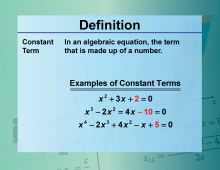
|
Definition--Equation Concepts--Constant Term | Constant TermTopicEquations DefinitionA constant term is a term in an algebraic expression that does not contain any variables. DescriptionConstant terms are fixed values in algebraic expressions and equations. They do not change because they lack variables. For example, in the expression 3x + 4 the number 4 is a constant term. Constant terms are essential in forming and solving equations. |
Variables and Unknowns |
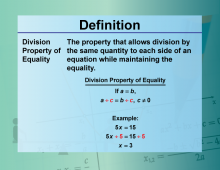
|
Definition--Equation Concepts--Division Property of Equality | Division Property of EqualityTopicEquations DefinitionThe Division Property of Equality states that if you divide both sides of an equation by the same nonzero value, the equality remains true. DescriptionThe Division Property of Equality is a key principle in algebra. It states that for any real numbers a, b, and c (where 𝑐 ≠ 0), if a = b, then a ÷ c = b ÷ c This property is used to solve equations by isolating variables. For example, to solve 3x = 12 divide both sides by 3 to get x = 4. |
Applications of Equations and Inequalities |

|
Definition--Equation Concepts--Equality | EqualityTopicEquations DefinitionEquality is a mathematical statement that asserts that two expressions are equal. DescriptionEquality is a foundational concept in mathematics. It indicates that two expressions have the same value, represented by the symbol "=". For example, in the equation 2 + 3 = 5, both sides are equal. Equality is used to form equations and solve problems. In real-world applications, equality is used in accounting, engineering, and data analysis to ensure balance and accuracy. Understanding equality helps students develop logical reasoning and problem-solving skills. |
Applications of Equations and Inequalities |
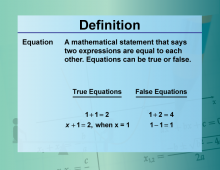
|
Definition--Equation Concepts--Equation | EquationTopicEquations DefinitionAn equation is a mathematical statement that asserts the equality of two expressions. DescriptionEquations are central to mathematics, representing relationships between quantities. They consist of two expressions separated by an equals sign. For example, 2x + 3 = 7 is an equation that can be solved to find x. Equations can be linear, quadratic, or polynomial, among others. |
Applications of Equations and Inequalities |
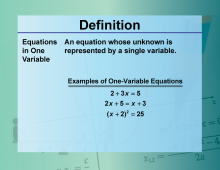
|
Definition--Equation Concepts--Equations in One Variable | Equations in One VariableTopicEquations DefinitionEquations in one variable involve a single variable and can be solved to find its value. DescriptionEquations in one variable are fundamental in algebra. They typically take the form of ax + b = 0, where x is the variable. Solving these equations involves isolating the variable to determine its value. For example, solving 2x + 3 = 7 yields x = 2 |
Applications of Equations and Inequalities |

|
Definition--Equation Concepts--Equations in Two Variables | Equations in Two VariablesTopicEquations DefinitionEquations in two variables involve two variables and describe a relationship between them. DescriptionEquations in two variables are essential in algebra and coordinate geometry. They typically take the form of ax + by = c and represent lines in a coordinate plane. For example, the equation 2x + 3y = 6 can be graphed as a line. |
Applications of Equations and Inequalities |
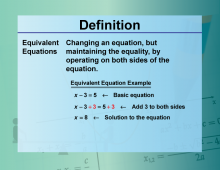
|
Definition--Equation Concepts--Equivalent Equations | Equivalent EquationsTopicEquations DefinitionEquivalent equations are equations that have the same solutions. DescriptionEquivalent equations are a key concept in algebra. They may look different but yield the same solutions. For instance, 2x + 3 = 7 and 4x + 6 = 14 are equivalent because both have the solution x = 2. Transformations such as addition, subtraction, multiplication, or division can produce equivalent equations. |
Applications of Equations and Inequalities |
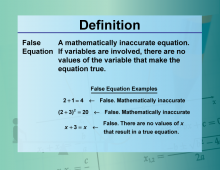
|
Definition--Equation Concepts--False Equation | False EquationTopicEquations DefinitionA false equation is an equation that is not true for any value of the variable(s). DescriptionFalse equations are equations that do not hold true for any value of the variable(s). For example, the equation x + 2 = x + 3 is false because there is no value of x that makes both sides equal. Identifying false equations is important in verifying the validity of mathematical statements. |
Applications of Equations and Inequalities |
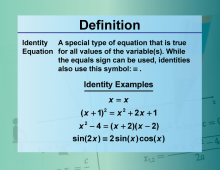
|
Definition--Equation Concepts--Identity Equation | Identity EquationTopicEquations DefinitionAn identity equation is true for all values of the variable(s). DescriptionIdentity equations are equations that hold true for all values of the variable(s). For example, the equation 2(x + 1) = 2x + 2 is an identity because it is true for any value of x. These equations are used to express mathematical identities and properties. In the equation above, the identity results from the use of the distributive property. |
Applications of Equations and Inequalities |
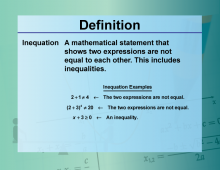
|
Definition--Equation Concepts--Inequation | InequationTopicEquations DefinitionAn inequation is a mathematical statement that shows the inequality between two expressions. DescriptionInequations, or inequalities, are statements that compare two expressions using inequality symbols such as >, <, ≥, and ≤. For example, x + 3 > 5 indicates that 𝑥 x must be greater than 2. Inequations are used to represent constraints and conditions in mathematical models. Inequations sometimes involve the inequality symbol: ≠. |
Inequalities |
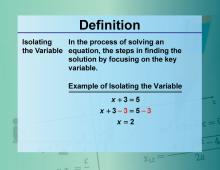
|
Definition--Equation Concepts--Isolating the Variable | Isolating the VariableTopicEquations DefinitionIsolating the variable involves manipulating an equation to get the variable alone on one side. DescriptionIsolating the variable is a fundamental technique in algebra used to solve equations. It involves performing operations to both sides of an equation to get the variable by itself. For example, solving 2x + 3 = 7 involves subtracting 3 and then dividing by 2 to isolate x, resulting in x = 2. |
Variables and Unknowns |
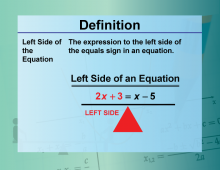
|
Definition--Equation Concepts--Left Side of the Equation | Left Side of the EquationTopicEquations DefinitionThe left side of the equation refers to the expression on the left side of the equals sign. DescriptionThe left side of an equation is the part of the equation that appears before the equals sign. For example, in the equation 2x + 3 = 7 the left side is 2x + 3. Understanding the left side of the equation is crucial for solving and balancing equations. In real-world applications, recognizing the left side of an equation helps in setting up and solving problems accurately. It is essential for students to understand this concept to manipulate and solve equations effectively. |
Applications of Equations and Inequalities |
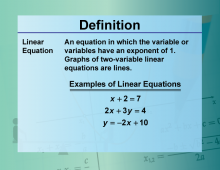
|
Definition--Equation Concepts--Linear Equation | Linear EquationTopicEquations DefinitionA linear equation is an equation that does not have an variables raised to a power higher than one. A linear equation can have one or more variables. DescriptionLinear equations are fundamental in algebra and describe relationships are summarized below. |
Applications of Linear Functions |
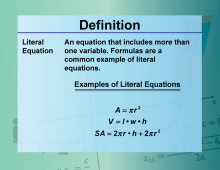
|
Definition--Equation Concepts--Literal Equation | Literal EquationTopicEquations DefinitionA literal equation is an equation that involves two or more variables. DescriptionLiteral equations involve multiple variables and are used to express relationships between them. For example, the formula for the area of a rectangle, A = l•w is a literal equation involving the variables l and w. Solving literal equations often involves isolating one variable in terms of the others. |
Applications of Equations and Inequalities |
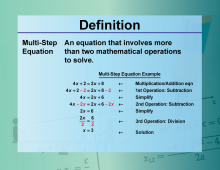
|
Definition--Equation Concepts--Multi-Step Equation | Multi-Step EquationTopicEquations DefinitionA multi-step equation requires more than one step to solve. DescriptionMulti-step equations involve multiple operations to isolate the variable. For example, solving 3x + 2 = 11 requires subtracting 2 and then dividing by 3 to find x=3. These equations are common in algebra and require a systematic approach to solve. In real-world applications, multi-step equations are used in complex problem-solving scenarios such as engineering and finance. Understanding how to solve multi-step equations helps students develop critical thinking and problem-solving skills. |
Solving Multistep Equations |
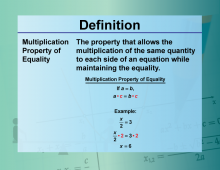
|
Definition--Equation Concepts--Multiplication Property of Equality | Multiplication Property of EqualityTopicEquations DefinitionThe Multiplication Property of Equality states that if you multiply both sides of an equation by the same nonzero value, the equality remains true. DescriptionThe Multiplication Property of Equality is a fundamental principle in algebra. It states that for any real numbers a, b, and c (where 𝑐 ≠ 0), if a = b, then ac = bc This property is used to solve equations by isolating variables. For example, to solve x/3 = 4 you multiply both sides by 3 to get x = 12. |
Applications of Equations and Inequalities |
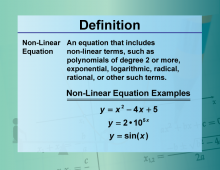
|
Definition--Equation Concepts--Nonlinear Equation | Nonlinear EquationTopicEquations DefinitionA nonlinear equation is an equation that graphs as a curve and does not form a straight line. DescriptionNonlinear equations are equations that involve variables raised to powers other than one or involve products of variables. For example, the equation y = x2 is nonlinear because it graphs as a parabola. These equations are used to model more complex relationships than linear equations. |
Applications of Equations and Inequalities |
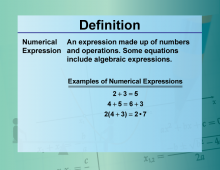
|
Definition--Equation Concepts--Numerical Expression | Numerical ExpressionTopicEquations DefinitionA numerical expression is a mathematical phrase involving numbers and operation symbols, but no variables. DescriptionNumerical expressions consist of numbers and operations such as addition, subtraction, multiplication, and division. For example, 3 + 4 × 2 is a numerical expression. These expressions are evaluated to find their value. In real-world applications, numerical expressions are used in everyday calculations such as budgeting, measuring, and data analysis. Understanding numerical expressions helps students perform arithmetic operations and develop computational skills. |
Numerical Expressions |
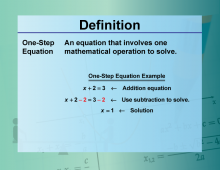
|
Definition--Equation Concepts--One-Step Equation | One-Step EquationTopicEquations DefinitionA one-step equation requires only one operation to solve. DescriptionOne-step equations are the simplest type of equations in algebra. They involve a single operation to isolate the variable. For example, solving x + 3 = 7 requires subtracting 3 from both sides to find x = 4. These equations are used in basic problem-solving scenarios and form the foundation for understanding more complex equations. Understanding one-step equations helps students develop confidence in solving algebraic problems and prepares them for advanced algebraic concepts. |
Solving One-Step Equations |
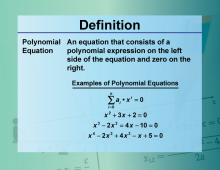
|
Definition--Equation Concepts--Polynomial Equation | Polynomial EquationTopicEquations DefinitionA polynomial equation is an equation that involves a polynomial expression. DescriptionPolynomial equations involve expressions that include terms with variables raised to whole-number exponents. For example, the equation x2 − 4x + 4 = 0 is a polynomial equation. These equations can be linear, quadratic, cubic, etc., depending on the highest power of the variable. |
Polynomial Functions and Equations |
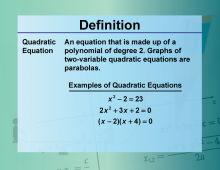
|
Definition--Equation Concepts--Quadratic Equation | Quadratic EquationTopicEquations DefinitionA quadratic equation is a polynomial equation of degree 2, typically in the form ax2 + bx + c = 0. DescriptionQuadratic equations are fundamental in algebra and involve variables raised to the second power. For example, the equation x2 − 4x + 4 = 0 is quadratic. These equations can be solved using methods such as factoring, completing the square, and the quadratic formula. |
Quadratic Equations and Functions |
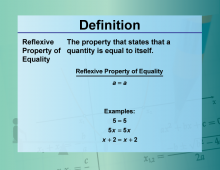
|
Definition--Equation Concepts--Reflexive Property of Equality | Reflexive Property of EqualityTopicEquations DefinitionThe Reflexive Property of Equality states that any value is equal to itself. DescriptionThe Reflexive Property of Equality is a basic principle in mathematics. It states that for any value a, a = a This property is used to justify steps in solving equations and proving mathematical statements. In real-world applications, the reflexive property underlies the concept of identity and is fundamental in logical reasoning and proofs. Understanding this property helps students build a strong foundation in algebra and develop rigorous mathematical arguments. |
Applications of Equations and Inequalities |
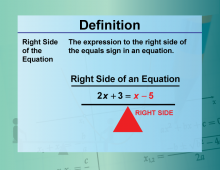
|
Definition--Equation Concepts--Right Side of the Equation | Right Side of the EquationTopicEquations DefinitionThe right side of the equation refers to the expression on the right side of the equals sign. DescriptionThe right side of an equation is the part of the equation that appears after the equals sign. For example, in the equation 2x + 3 = 7 the right side is 7. Understanding the right side of the equation is crucial for solving and balancing equations. |
Applications of Equations and Inequalities |
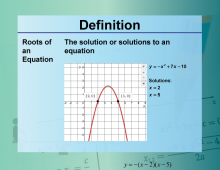
|
Definition--Equation Concepts--Roots of an Equation | Roots of an EquationTopicEquations DefinitionThe roots of an equation are the values of the variable that satisfy the equation. DescriptionThe roots of an equation are the solutions that make the equation true. For example, the roots of the quadratic equation x2 − 4x + 4 = 0 are x = 2 because substituting 2 into the equation satisfies it. Finding roots is a fundamental task in algebra. |
Applications of Equations and Inequalities |

|
Definition--Equation Concepts--Solution | SolutionTopicEquations DefinitionA solution is the value(s) of the variable(s) that satisfy an equation. DescriptionThe concept of solution is fundamental in equations, referring to the values that make the equation true. For example, in the equation x + 2 = 5 the solution is x = 3 because substituting 3 in place of x results in a true statement. Solutions can exist for various types of equations, whether single-variable, multi-variable, linear, or nonlinear. |
Applications of Equations and Inequalities |
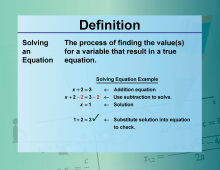
|
Definition--Equation Concepts--Solving an Equation | Solving an EquationTopicEquations DefinitionSolving an equation involves finding the value(s) of the variable(s) that make the equation true. DescriptionSolving an equation is a key skill in algebra, where one determines the values of variables that satisfy the equation. For example, in the equation 2x + 3 = 7 one can find that x = 2 by isolating the variable through algebraic manipulations. Different techniques such as substitution, factoring, or using the quadratic formula may apply depending on the complexity of the equation. |
Applications of Equations and Inequalities |
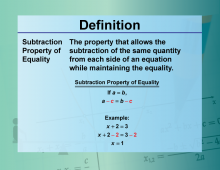
|
Definition--Equation Concepts--Subtraction Property of Equality | Subtraction Property of EqualityTopicEquations DefinitionThe Subtraction Property of Equality states that if you subtract the same value from both sides of an equation, the equality remains true. DescriptionThe Subtraction Property of Equality is a fundamental principle in algebra. It states that for any real numbers a, b, and c, if a = b, then a − c = b − c This property is used to solve equations by isolating variables. For example, to solve x + 3 = 7 you subtract 3 from both sides to get x = 4. |
Applications of Equations and Inequalities |